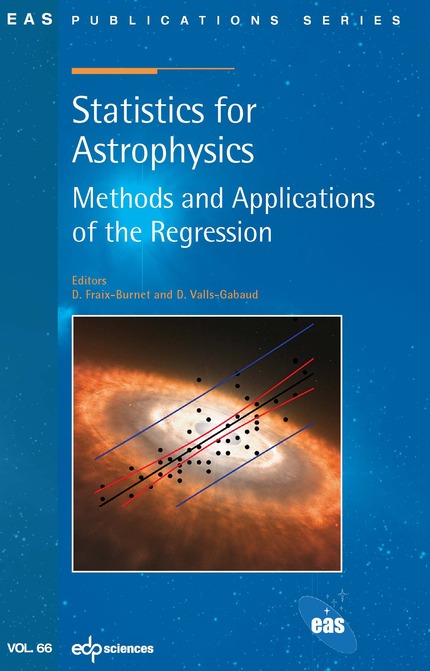
Les comptes-rendus sont publiés dans l'European Astronomical Society Publications Series chez EDPSciences en version électronique ou papier.
Les Codes R et les Données sont disponibles sur ce site.
La contribution de Stefano Andreon ne se trouve pas dans les comptes-rendus, mais vous pouvez consuter sa présentation : Bayesian Regression Methods
Ci-dessous la table des matières détaillées (pdf) :
REGRESSION MODELS: A BRIEF INTRODUCTION (G. Grégoire) 3
1 Some history 3
2 Simple Linear Regression 4
3 Multiple Linear Regression 5
4 Generalized linear regression 6
4.1 Logistic regression 7
4.2 Poissonian regression 7
5 Further in regression models 8
PRACTICAL SESSION 1. INTRODUCTION TO R (M. Clausel, G. Grégoire) 11
1 More about R 11
2 First steps. 12
3 Random distributions 14
4 Empirical description 15
5 Reading data in a file 17
6 A toy example 18
SIMPLE LINEAR REGRESSION (G. Grégoire) 19
1 Introduction. Statistical issues 19
2 Model, assumptions 21
3 Least Square Method and basic results 22
3.1 Least Square Method (OLS) 22
3.2 Fitted values, residuals and estimate σ 2 24
3.3 Basic statistical properties 24
3.4 Confidence Intervals and Tests 26
4 Variance decomposition. ANOVA table and R2 27
4.1 Some comments 28
4.2 The R2 and adjusted R2 coefficients 28
4.3 The ANOVA table 30
5 Confidence Intervals for the mean and Forecast Intervals 31
5.1 Confidence intervals for the mean 31
5.2 Prediction intervals 31
5.3 Plots of CI and PI intervals using R 32
6 Residuals and diagnostics 32
6.1 Residuals and h-values 32
6.2 Diagnostic analysis : outliers, influent observations, observations 34
with high leverage effect 20
6.3 Diagnostic analysis for cars data using R 36
7 Dealing with departures from model assumptions and practical issues 38
7.1 Transformations 38
7.2 Non-linearity 39
7.3 Non-normality 39
7.4 Heteroscedasticity 40
7.5 Several data sets with different departures from model assumptions but same basic statistical information 41
PRACTICAL SESSION 2. SIMPLE LINEAR REGRESSION (M. Clausel, G. Grégoire) 41
1 Study of Galton’s data on hereditary of size 41
2 Vapor tension of mercury 43
MULTIPLE LINEAR REGRESSION (G. Grégoire) 45
1 Introduction 45
2 Model and assumptions 48
3 Least Square Method and basic results 50
3.1 Least Square Method (OLS) 50
3.2 Fitted values, residuals and variance estimate 51
3.3 Basic statistical properties 52
3.4 Confidence intervals for the coefficients and individual tests 54
4 ANOVA table and R2 56
4.1 Some comments 56
4.2 The ANOVA table and the global test 56
4.3 The R2 coefficient and the adjusted R2 58
5 Confidence Intervals for the mean and Forecast Intervals 60
5.1 Confidence intervals for the mean 60
5.2 Prediction intervals 61
6 Comparing models and testing linear hypotheses 61
7 Selecting variables and model choice 64
8 Residuals and diagnostics 66
8.1 Residuals and h-values 66
8.2 Diagnostic analysis : outliers, influent observations, observations with high leverage effect 68
8.3 Diagnostic analysis for Wagesdata using R 69
9 Dealing with departures from model assumptions and practical issues 71
PRACTICAL SESSION 3. MULTIPLE LINEAR REGRESSION (M. Clausel, G. Grégoire) 73
1 An example of multiple linear regression 73
2 Model selection 74
3 Analysis of variance 75
SOME REGRESSION PROBLEMS IN SOLAR-TERRESTRIAL SCIENCES: LEARNING FROM MISTAKES (T. Dudok de Wit) 77
1 What not to do in regression analysis 77
2 Trend determination: is the sky falling down? 78
3 Multilinear regression: desperately searching for solar signatures 80
4 Power laws: are there lines everywhere? 83
5 Conclusion 86
LOGISTIC REGRESSION (G. Grégoire) 89
1 Introduction 89
1.1 The model 90
1.2 Odds and Odds ratio 91
1.3 Interpretation of coefficients in logistic regression 94
2 Maximum likelihood method 95
2.1 Wald, Rao, LR fundamental results in maximum likelihood theory 96
2.2 MLE in logistic regression 97
2.3 WAGES example 99
3 Models comparison. Deviance. R2 Coefficient. 103
3.1 Comparing nested models in general likelihood theory 103
3.2 Comparing nested models in logistic regression 103
3.3 Deviance, Pearson chi-square 104
3.4 Some R2 coefficients 106
4 Residuals, influence measure, h-values, classification tables and ROC
curve 107
4.1 Residuals 107
4.2 h-values and leverage effect 108
4.3 Influence detection 108
4.4 Classification table and ROC curve 109
5 Some additional topics 110
5.1 Binomial data 110
5.2 Polytomous logistic regression 113
5.3 Ordinal logistic regression 114
5.4 Discriminating between Stars and Quasars 116
PRACTICAL SESSION 4. LOGISTIC REGRESSION (M. Clausel, G. Grégoire) 121
SURVIVAL DATA AND REGRESSION MODELS (G. Grégoire) 125
1 Introduction 125
1.1 Notation and specific statistical tools 126
1.2 Censoring 130
1.3 Statistical issues 131
2 The Kaplan-Meier estimate of S 131
3 The likelihood method 134
3.1 Some reminders on the maximmum likelihood method 134
3.2 The likelihood function for censored survival data 135
4 Some parametric models 136
4.1 The exponential distribution 136
4.2 The Weibull distribution 137
4.3 The logistic and log-logistic distributions 138
5 AFT regression models 138
5.1 The Accelerated Failure Time models 138
5.2 The exponential regression model 140
5.3 The Weibull regression model 141
5.4 The log-logistic regression model 141
5.5 AFT regression models dealed with R 142
6 The Cox regression model 144
6.1 Interpretation of βi coefficients in Cox regression 145
6.2 Maximum likelihood estimation 146
6.3 Stratified Cox model 146
6.4 Fitting a Cox regression model with R 147
LINEAR REGRESSION IN HIGH DIMENSION AND/OR FOR CORRELATED INPUTS (J. Jacques and D. Fraix-Burnet) 149
1 Introduction 149
2 Methods using Derived Input Directions 151
2.1 Regression on Principal Components 151
2.2 Partial Least Square regression 152
2.3 Application on astronomy data 152
2.3.1 The data 152
2.3.2 The R package 153
2.3.3 The analysis 153
3 Shrinkage methods 155
3.1 Ridge regression 156
3.2 Lasso regression 157
3.2.1 Least Angle Regression 158
3.3 Elastic-net regression 159
3.4 Application on astronomy data 159
3.4.1 The R packages 159
3.4.2 The analysis 160
3.5 Extensions 164
AN INTRODUCTION TO DIMENSION REDUCTION IN NONPARAMETRIC KERNEL REGRESSION (S. Girard, J. Saracco) 167
1 Introduction 167
2 An introduction to nonparametric kernel regression 168
2.1 Nonparametric density estimation 168
2.2 Unidimensional nonparametric regression 170
2.2.1 Moving average estimator 170
2.2.2 Kernel estimator 171
2.3 Multidimensional nonparametric regression 173
2.3.1 Kernel estimator 173
2.3.2 Bias/variance trade-off 175
2.3.3 Bandwidth selection with cross-validation 177
2.3.4 An illustration on simulated data 177
2.4 Some extensions 178
2.4.1 Structured kernels 179
2.4.2 Local polynomial regression 180
2.4.3 Local likelihood 182
3 Dimension reduction based on sliced inverse regression 183
3.1 The semi-parametric regression model 183
3.2 The basic ideas behind SIR 184
3.3 Some extensions of SIR approach 187
3.4 Closest Submodel Selection (CSS) 188
3.5 An illustration on simulated data 189
4 Application to astronomy data 191
SPATIAL PATTERNS ANALYSIS IN COSMOLOGY BASED ON MARKED POINT PROCESSES (R. Stoica) 197
1 Introduction 197
2 Modelling : build a marked point process 199
2.1 Poisson and interacting point process 200
2.2 Manipulating point processes 202
2.3 Models 205
3 Monte Carlo simulation 209
4 Statistical inference 215
4.1 Parameter estimation 215
4.2 Pattern detection 218
5 Morpho-statistical characterization of cosmic filaments 225
6 Conclusion and perspectives 226
Codes and Data 227



